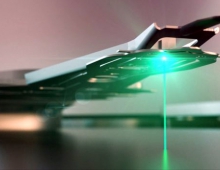
SDK Develops Microwave-based New Materials for Printed Electronics
Showa Denko K.K. (SDK) has developed a microwave-heating printing technology to form electronic circuits on flexible printed circuit substrates (FPCs), in which plastic films and other materials with low heat resistance are used.
As part of the new technology, SDK has developed a printable silver/carbon hybrid conductive ink and an ink-curing unit. SDK has also developed a printable conductive adhesive usable in microwave-heating, thereby significantly reducing migration that causes deterioration in product quality. Migration is the movement of metals on the surface of or inside a nonmetallic medium, resulting in short circuit. As a result, it has become easy to form electronic circuits on FPCs and mount devices by printing.
SDK will, through its subsidiary Shoko Co., Ltd., start selling the ink-curing unit, as well as offering samples of the silver/carbon hybrid conductive ink and the conductive adhesive.
Technology details
In printed electronics, conductive inks printed on substrates are heated and cured to form electronic circuits. When low-heat-resistant substrates and parts are to be used, it becomes necessary to heat required portions only, using selective heating technologies.
Microwave heating is one of the selective heating technologies, as is Photonic Curing process technology already introduced by SDK. Microwave heating is suited for printing on low-heat-resistant plastic films and for roll-to-roll continuous printing. Furthermore, microwave can penetrate into a substrate, enabling the formation of conductors inside a substrate and the bonding of internal parts.
In the conventional microwave heating, there is a problem of spark discharge involving conductive inks that contain metallic materials. SDK has developed a new technology, jointly with Professor Yuji Wada, of Tokyo Institute of Technology, and The National Institute of Advanced Industrial Science and Technology (AIST), to control spark discharge by separating microwave?s magnetic field and electric field and applying the fields separately in heating.
In SDK's newly developed silver/carbon hybrid conductive ink optimized for this technology, carbon particles (which do not develop a phase change during heating) have been added to silver particles. This step ensures uniform curing of the ink under microwave heating, preventing a non-uniform distribution of conductivity. Conventional silver inks tend to develop, upon absorption of microwave, a non-uniform phase change due to melting, resulting in non-uniform distribution of conductivity.
In the wiring of electronic circuits, silver-containing conductive adhesives are generally used to ensure conductivity. However, silver tends to cause migration due mainly to halogen components contained in peripheral materials. SDK has developed, jointly with Professor Katsuaki Suganuma, of Osaka University, a halogen-free conductive adhesive, enabling substantial reductions in migration.
This adhesive can also be used with the newly developed microwave-heating equipment. The adhesive can be printed on a plastic film, and subjected to heating and curing with devices being mounted on the substrate.
SDK will continue to work to develop and commercialize materials for printed electronics through collaboration with outside partners.
SDK will, through its subsidiary Shoko Co., Ltd., start selling the ink-curing unit, as well as offering samples of the silver/carbon hybrid conductive ink and the conductive adhesive.
Technology details
In printed electronics, conductive inks printed on substrates are heated and cured to form electronic circuits. When low-heat-resistant substrates and parts are to be used, it becomes necessary to heat required portions only, using selective heating technologies.
Microwave heating is one of the selective heating technologies, as is Photonic Curing process technology already introduced by SDK. Microwave heating is suited for printing on low-heat-resistant plastic films and for roll-to-roll continuous printing. Furthermore, microwave can penetrate into a substrate, enabling the formation of conductors inside a substrate and the bonding of internal parts.
In the conventional microwave heating, there is a problem of spark discharge involving conductive inks that contain metallic materials. SDK has developed a new technology, jointly with Professor Yuji Wada, of Tokyo Institute of Technology, and The National Institute of Advanced Industrial Science and Technology (AIST), to control spark discharge by separating microwave?s magnetic field and electric field and applying the fields separately in heating.
In SDK's newly developed silver/carbon hybrid conductive ink optimized for this technology, carbon particles (which do not develop a phase change during heating) have been added to silver particles. This step ensures uniform curing of the ink under microwave heating, preventing a non-uniform distribution of conductivity. Conventional silver inks tend to develop, upon absorption of microwave, a non-uniform phase change due to melting, resulting in non-uniform distribution of conductivity.
In the wiring of electronic circuits, silver-containing conductive adhesives are generally used to ensure conductivity. However, silver tends to cause migration due mainly to halogen components contained in peripheral materials. SDK has developed, jointly with Professor Katsuaki Suganuma, of Osaka University, a halogen-free conductive adhesive, enabling substantial reductions in migration.
This adhesive can also be used with the newly developed microwave-heating equipment. The adhesive can be printed on a plastic film, and subjected to heating and curing with devices being mounted on the substrate.
SDK will continue to work to develop and commercialize materials for printed electronics through collaboration with outside partners.





















